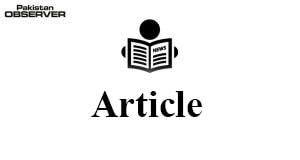Fourth industrial revolution: Challenges & opportunities
DURING 2016 world economic forum conference, Clause Schwab, the founder of World Economic Forum, highlighted that emerging technologies such as Artificial Intelligence (AI), Big Data Analytics, Robotics, Block Chain, Quantum Computing, Informational and communication technologies (ICTs), 5G and nanotechnology are bound to profoundly impact human lives.
He coined the term Fourth Industrial Revolution. Industrial revolutions always greatly influenced human lives by disrupting existing processes and introducing new technologies.
The first industrial revolution occurred in the late 18th century and early 19th century and ushered in a new age of mass production and factory work. Machine tools, massive-scale textile production and steam power were all used for the first time.
The second industrial revolution emerged about a century later and represented the rapid evolution of technology in the manufacturing sector. During this time, use of electricity, the telegraph and railroad were popularized. The third
industrial revolution started during the latter half of the 20th century until recently and can be summed up as the transition from Analog Technologies to digital technologies.
During this period, integrated circuit chips, the internet, digital cell phones and computers became a part of every person’s life.
These three industrial revolutions transformed how businesses were run — from introducing the idea of the factory, efficient production and transportation methods and digital computers to supply chains.
It is apparent that each industrial revolution further accentuated the divide between developed and developing regions of the world.
As the developed nations have entered into the fourth industrial revolution a significant segment of world population from developing countries is yet to witness advancements of second and third industrial revolutions.
It is estimated that the 1.2 billion world population has no access to electricity and 40% of the world population mainly belonging to developing countries has no access to the internet.
The fourth industrial revolution is going to disrupt existing processes and technologies like the previous three industrial revolutions, but with enormous impact and faster speed. Like previous industrial revolutions it is going to create a new elite.
The effects of 4 IR are already being witnessed in the form of weak job growth and stagnant wages in traditional sectors contrasted with the booming fortunes of technology unicorns (a term used in the venture capital industry to describe a privately held startup company with a value of over $1 billion) and their founding members. The benefits are accruing to those who are literate and capable of taking advantage of emerging technologies.
These people reside in and around high-wealth, high-income innovation hubs such as Silicon Valley. On the flipside, the core of industrialized economies where millions of blue-collar jobs have historically resided has hollowed out, leading to diminishing of prosperity.
Experts have developed a helpful framework for assessing the employment and wage effects of technological innovation.
According to this framework, there are, broadly speaking, two types of innovations: enabling technologies and replacing technologies. Enabling technologies expand the productivity of labour and lead to higher employment and wages.
Modern examples are computer-aided design (CAD) and statistical software for economic and social analysis.
Replacing technologies, in contrast, substitute for labour, making workers less useful and lowering their wages. Modern examples are industrial robots for car manufacturing and software for accounting and tax reporting.
Developed economies are successful to mitigate job loss threats emanating from replacement technologies because of stronger wealth, institutions capable of implementing forward-looking policies and a historic track record of successfully dealing with the industrial revolutions of the past.
However, the developing economies have to bear the brunt of automation. A World Bank report suggests that two-thirds of all jobs in the developing world are at risk of being lost through automation.
Coming over to Pakistan’s case; Pakistan is ranked among those developing countries which have brighter chances to benefit from 4IR technologies. The information technology sector is one of the throbbing sectors of the country.
It is a fact that successive governments have encouraged the flourishing of this sector. It is a fact that Pakistan, as a nation-state, always accepted challenges of modern technologies.
As a state, Pakistan encourages its scientists and engineers to contribute to progress and strengthening of national defence of the country.
Pakistan’s status as a de jure nuclear state, indigenous development of high-tech fighter aircraft, significant contribution to the world’s IT market of world are some of the major contributions by scientists, engineers and IT professionals of this country.
With a youth population of over 60% and healthy internet penetration and relatively satisfactory literacy rate of 62.3%, Pakistan is well poised to cope with challenges of the fourth industrial revolution.
To seize this opportunity, the government has started different measures for capacity building.
These measures include the HEC initiative for establishing centres of excellence for Robotics, Artificial Intelligence, Big Data Analytics and Cyber Security.
Another significant step towards harnessing 4IR advantages is the Presidential Initiative for Artificial Intelligence & Computing (PIAIC) which is significantly contributing to capacity building of the younger generation.
Ignite which is a national technology fund is established with the aim to promote startups by encouraging knowledge economy. To succeed in the fourth industrial revolution, it is imperative that a nation’s cyber infrastructure should be safeguarded against threats such as cyber-attacks.
Moreover, state’s policies such as provision of basic necessities to common people, freedom of social media, will yield a national response as large strata of society will be participating for making Pakistan more prosperous and stronger.
—The writer is contributing columnist, based in Islamabad.










